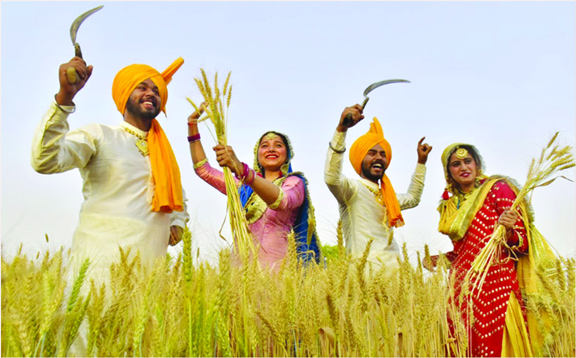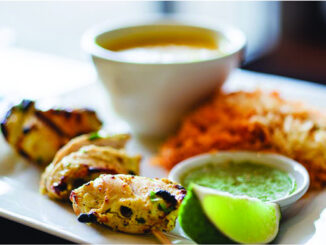
Vaisakhi, also known as Baisakhi, is a harvest festival celebrated in India and in parts of the world largely by the Sikh community. The day holds great significance and is celebrated as Sikh New Year, based on the solar calendar. This year, it will be celebrated on April 14, a Thursday.
History and significance
For the Sikh community, Baisakhi is not only a harvest festival, but also a religious one. On March 30, 1699, on Vaisakhi, Guru Gobind Singh established the Khalsa, which is the ‘pure’ Sikh community. On this day, the Guru asked people to sacrifice their life for the Lord.
Five people volunteered and they later came to be known as ‘panj piaras‘.Sikhs visit gurudwaras on the day of Baisakhi, and in Punjab, specifically, langars are organised at various places. Traditionally, kada prasad (wheat halwa) is served.People wear new, colourful clothes and in the evenings, perform bhangra (Punjabi folk dance). Processions of nagar kirtans are also carried out, which involve singing and chanting from the holy book, Guru Granth Sahib. Other than Punjab, the festival is also celebrated in other states, like in Haryana, where a Baisakhi Fair is organised.
Celebrations
People of Punjab celebrate the festival of Baisakhi with exuberance and devotion. As the festival has tremendous importance in Sikh religion, major activities of the day are organized in Gurdwaras. People wake up early to prepare for the day. Many also take bath in the holy river to mark the auspicious occasion. After getting ready people pay a visit to their neighbourdood gurdwara and take part in the special prayer meeting organized for the day. At the end of the Baisakhi ardas, congregates receive specially prepared Kara prasad or sweetened semolina. This is followed by a guru ka langar or community lunch. Later, during the day people of Sikh faith take out a Baisakhi procession under the leadership of Panj piaras. The procession moves through the major localities of the city amidst the rendition of devotional songs by the participating men, women and children. Mock duels, bhangra and gidda performances make the procession joyous and colorful.
Celebrations by Farmers
For the large farming community of Punjab and Haryana, Baisakhi marks a New Year’s time as it is time to harvest rabi crop. On Baisakhi, farmers thank god for the bountiful crop and pray for good times ahead. People buy new clothes and make merry by singing, dancing and enjoying the best of festive food. Cries of “Jatta aai Baisakhi”, rent the skies as gaily men and women break into the bhangra and gidda dance to express their joy. Everyday farming scenes of sowing, harvesting, winnowing and gathering of crops are expressed through zestful movements of the body to the accompaniment of ballads and dhol music. In several villages of Punjab Baisakhi Fairs are organized where besides other recreational activities, wrestling bouts are also held.
History
Baisakhi or Vaisakhi Festival is celebrated as the Sikh New Year and the founding of the Khalsa Panth. History of Baisakhi traces its origin from the Baisakhi Day celebrations of 1699 organized by the Tenth Sikh Guru, Guru Gobind Singh to form Khalsa – Brotherhood of Saint Soldiers to fight against tyranny and oppression.
Story of Baisakhi
The story of Baisakhi Festival began with the martyrdom of Guru Teg Bahadur, the ninth Sikh Guru who was publicly beheaded by the Aurungzeb, the Mughal ruler. Aurungzeb wanted to spread Islam in India and Guru Tegh Bahadur stood up for the rights of Hindus and Sikhs and the Mughals therefore saw him as a threat. After the death of Guru Teg Bahadur, his son, Guru Gobind Singh became the next Guru of the Sikhs. Guru Gobind Singh wished to instill courage and strength to sacrifice among his fellow men. To fulfil his dream, Guru Gobind Singh called on the historic Baisakhi Day congregation of Sikhs at Keshgarh Sahib near Anandpur on March 30, 1699.When thousands of people assembled for Guru’s blessing, Guru Gobind Singh came out of the tent carrying an unsheathed sword. He gave a powerful speech to infuse courage amongst fellowmen. At the end of the speech he said that every great deed was preceded by equally great sacrifice and demanded that anyone prepared to give his life come forward. On the Guru’s third call, a young man offered himself. The Guru took the man inside a tent and reappeared alone with a bloodied sword. Guru Gobind Singh asked for another volunteer. This was repeated another four times until a total of five Sikhs had gone into the tent with the Guru. Everyone present was worried and though that Guru Gobind Singh has killed five Sikhs. At this point Guru presented all the five men before the people. Every one present was surprised to see all five men alive and wearing turbans and saffron-coloured garments. These five men were called Panj Piara or ‘Beloved Five’ by the Guru.The Guru blessed them with a Pahul ceremony. In an iron vessel, the Guru stirred with a sword called Khanda Sahib, the batasha that his wife, Mata Sundari Ji had put into water.
The congregation recited verses from scriptures as the Guru performed the sacred ceremony. The water was now considered the sacred nectar of immortality called amrit. It was first given to the five volunteers, then drunk by the guru and later distributed amongst the crowd. With this ceremony, all those present, irrespective of caste or creed, became members of the Khalsa Pantha (the Order of the Pure Ones). The Guru regarded the Panch Piaras as the first members of the Khalsa and the embodiment of the Guru himself. With the constitution of the Panj Pyare the high and low castes were amalgamated into one as among the original Panj Pyare, there was one Khatri, shopkeeper; one Jat, farmer; one Chhimba, calico printer; one Ghumar, water-carrier; and one Nai, a barber. The Guru gave the surname of Singh (Lion) to every Sikh and also took the name for himself. From Guru Gobind Rai he became Guru Gobind Singh. This was seen as a great step in national integration because society at that time was divided on the basis of religion, caste and social status. Guru Gobind Singh also bestowed on Khalsa, the unique Sikh identity. He directed Sikhs to wear five K’s: Kesh or long hair, Kangha or comb, Kripan or dagger, Kachha or shorts and a Kara or bracelet. Guru Gobind Singh also discontinued the tradition of Gurus and asked all Sikhs to accept the Grantha Sahib as their eternal guide. He urged them to come to him with their hair and beard unshorn to get baptized by the sword.
What Rituals Are Performed
In the morning, Sikhs visit the gurudwara (temple) to attend special payers. Most Sikhs strive to visit the revered Golden Temple in Amritsar or Anandpur Sahib, where the Khalsa was pronounced. The Granth Sahib, or Holy Scripture, is bathed with milk and water, placed on a throne, and read. Karah prasad (sacred pudding made from butter, sugar and flour) is distributed.
In the afternoon, the Granth Sahib is taken out during a procession, accompanied by music, singing, chanting, and performances. Sikhs also offer also kar serva by helping in the daily chores of the gurudwaras. This is a traditional symbol of humanity for all Sikhs.





Be the first to comment